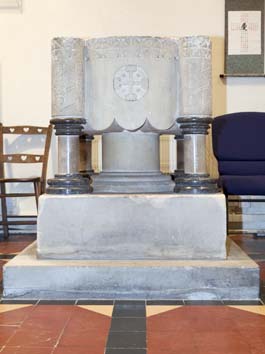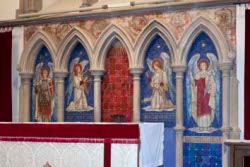Bexhill – St Mark, Little Common
St Mark was built in 1842 as a chapel of ease in the parish of St Peter for the hamlet of Little Common (1 p9). It was designed by M Vidler and comprised an aisleless nave with a west tower and a small east recess (ICBS). Much of the material is said to have come from a nearby Martello tower (VCH 9 p123). As then built, it cost £600 (1 p10), but little of this date has survived a complex subsequent development except, possibly, the rather spindly timbers of the nave roof. In 1857 the chapel became a district church (ibid p18) and H Woodyer designed a new chancel with lancets (ICBS). Once again, stone from one of the nearby Martello towers was used and the new work is quite modest for it only cost £555 (1 p22). In fact, by 1875 only £1346 in all is said to have been spent on the church (PP125), though this may as so often with this source be an under-estimate.
A separate parish was constituted in 1867 (1 p23), but no changes were made to the fabric until 1884, when tenders for enlargement to plans by the local architects Riches and Esam were sought (B 13 Dec 1884 p ii). These cannot have been carried out for Woodyer returned in 1885 and added a broad, gabled south aisle (WSRO Ep II/27/89 and ICBS), also with lancets and a five-bay arcade with round piers into which the moulded heads merge. He also heightened the chancel arch (Clarke papers) and may have done other work on the chancel (WSRO Ep ibid), as well as lengthening the nave to the west. Presumably because his aisle faces the road, concealing the nave, a replacement stone belfry was placed above its west end rather than that of the nave, though Woodyer is said to have proposed a tower (1 p26). The final result hardly confirms his high reputation, for it differs little from most other modest churches of the period. Only the sedilia in the chancel, fitted into the south east window sill, suggest an architect of originality.
In 1931 a vestry was added at the north east corner of the nave, replacing one of 1885. Its arch resembles that opposite on the south side and it was intended as the start of a north aisle by T Moore and Moore (i e L T Moore by this date) (CDG Sept 1930 p243). However, no more was done until 1962, when J D Wylson added an aisle (1 p40), separated from the nave by a long single very depressed arch with simplified gothic detail, effectively incorporating the vestry of 1931 as a transept to the east of the aisle. Wylson died during the work, which was completed by his partner, R C Cox (ibid). Cox also probably designed the south porch added in 1970 (ibid).
Fittings
Font: Big and round with squat shafts and a deep bowl of quatrefoil section with a scalloped base, designed by Woodyer (Clarke papers). It is said to be of Caen stone.
Glass:
The church contains a remarkable range of glass, largely of the C20. Much reflects the various building campaigns, but there have been further additions since.
1. (East window) Clayton and Bell, 1885 (www.stainedglassrecords.org, retrieved on 22/2/2013)
2. (South aisle, east) C E Kempe, 1896.
3. (West lancets) By ‘Drake’ with Christ with the children (www.stainedglassrecords.org, retrieved on 22/2/2013), 1890. From the date this is probably F Drake.
4. (West window) C E Kempe, 1898.
5. (South aisle, fourth window) Christian symbols by H Wilkinson, 1928 (WSRO Fac 2708).
6. (South aisle, first window) H V Milner, 1931 (CDG Jan 1931).
7. (North transept) four lights showing Christ and the Doctors by J Powell and Sons, designed by E L Armitage, 1961 (Order book).
8. (North transept, five lights) Raising of Lazarus by C J Edwards, 1964 (ESRO Par 245/4/1/24).
9. (South chancel, two pairs of lancets) Scenes from the Passion in an expressionist style by C J Edwards, 1966 (one signed).
10. (South chancel) Two-light window showing two saints, clearly influenced by early Victorian examples by C M Benyon, daughter of C J Edwards, 1986 (www.stainedglassrecords.org, retrieved on 22/2/2013).
11. (North aisle) Five lights depicting the Life of St Peter by C M Benyon, 1993 (ibid).
12. (South aisle, fifth window) Mostly engraved glass with addition of muted colouring, commemorating RAF Wartling, a radar station in World War II and subsequently, by J Campbell, 2001 (ibid)
Reredos: It consists of a row of stone arcading under the east window and was probably part of Woodyer’s design. However, in that case the tiled and mosaic angels within the arches are later, for the later of the couple commemorated died in 1915. This is almost certainly the work of 1922 by J Powell and Sons, designed by E Penwarden, as noted on Dennis Hadley’s list.
Rood-screen: Designed by H Read, 1926 (1 p80). It is well carved and the names of the saints depicted are said to spell out ALGERNON, the name of the person commemorated. However, the figure of St Mark in the centre (identified beyond doubt by his lion) might cast doubt on this.
Source
1. W Boorman: The History of St Mark’s Church, 2008
My thanks to Nick Wiseman, not only for all the photographs but also for much valuable information and comments about the church and especially the glass









